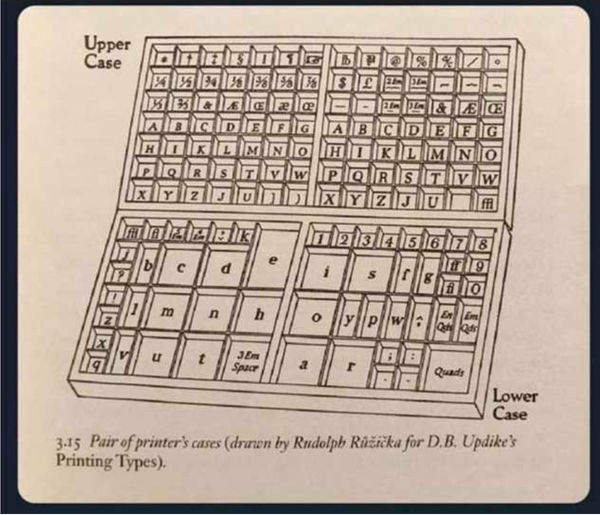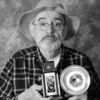From the I didn’t know that file.
Feb 12, 2020 18:24:39 #
Feb 13, 2020 06:53:32 #
RixPix wrote:
The terms upper case and lower case origin
Brings back memories of when I started working in newspapers back in the day. If I remember they were quite large to accomadate each wooden block that had a metal outline of the character in reverse. These were then placed by hand into rails to produce the text that would appear in print. A very skilfull job that was very well paid!
Feb 13, 2020 08:04:06 #
I actually knew this because my grandfather worked as a printers apprentice in his youth before he got lead poisoning.
Feb 13, 2020 08:39:43 #
FrankR
Loc: NYC
Learned about that in a 7th grade printing shop class. As has been said, it required skill and pros got paid well.
Feb 13, 2020 13:59:53 #
drucker
Loc: Oregon
Several oft-used phrases also come from printing.
"Mind your p's and q's" comes from those letters being easily confused because the letters are reversed on the piece of type so that they print correctly when inked and pressed to paper. The b's and d's and n's and u's also need close attention when taking letters from or returning them to the proper compartment of the case.
To be "out of sorts" also comes from printing. Each individual letter or symbol is known as a "sort" and thus if you used all of the e's in the case, it could be said that you were "out of sorts." And if there was no backup supply and you were working on a rush job, it would certainly have a an impact on your disposition.
"Mind your p's and q's" comes from those letters being easily confused because the letters are reversed on the piece of type so that they print correctly when inked and pressed to paper. The b's and d's and n's and u's also need close attention when taking letters from or returning them to the proper compartment of the case.
To be "out of sorts" also comes from printing. Each individual letter or symbol is known as a "sort" and thus if you used all of the e's in the case, it could be said that you were "out of sorts." And if there was no backup supply and you were working on a rush job, it would certainly have a an impact on your disposition.
Feb 13, 2020 14:10:38 #
Well now I can say I have learned something new today. Quite interesting and makes sense for the inception of the terms.
Feb 13, 2020 14:36:43 #
MrMophoto
Loc: Rhode Island "The biggest little"
When I first started studying graphic design, this was what we used to set type. A lot of print terms come from that process. Cut & Paste was literally cutting and pasting a block of type copy onto a mock up. also when setting type to be printed the block of type was locked into a metal frame called a chase, the devices that locked in the type are called quoins, I was told the derivation of the phrase "to coin a phrase" is actually supposed to be "to quoin a phrase" as to lock it in. Most people think that phrase refers to a coin as in striking or creating metal money, but I was also told the term quoin predates the term coin.
Feb 13, 2020 15:33:51 #
Brings back a lot of memories. The size of each compartment corresponds roughly to the frequency the letter is used on the printed page.
That's what's called a California Type Case.
For most type, there's a notch cut in each piece to denote the pica size of the type, and whether it was standard, bold, or italics. After a while you could catch missorted type by feel. We had composing sticks of several sizes, and when you got proficient, you could set and read at the same time. The spacers at the top and bottom of the page, and paragraphs, are EM spacers, between lines are EN spacers.
You would fill the composing stick, then remove the set type to a composing table and keep everything in line, set another stick, and repeat until finished. On the composing table, you'd set the page into a frame, center it, and use wooden blocks and key sets to tighten the setting. We'd then use a wooden block and mallet to ensure the type was completely level. Then you'd mount the frame into the press bed, ink up the plate, and print a test page, proof read it, then set pins in the kraft paper on the platen, then fire up the press. A good pressman could do around 120 ppm.
That's what's called a California Type Case.
For most type, there's a notch cut in each piece to denote the pica size of the type, and whether it was standard, bold, or italics. After a while you could catch missorted type by feel. We had composing sticks of several sizes, and when you got proficient, you could set and read at the same time. The spacers at the top and bottom of the page, and paragraphs, are EM spacers, between lines are EN spacers.
You would fill the composing stick, then remove the set type to a composing table and keep everything in line, set another stick, and repeat until finished. On the composing table, you'd set the page into a frame, center it, and use wooden blocks and key sets to tighten the setting. We'd then use a wooden block and mallet to ensure the type was completely level. Then you'd mount the frame into the press bed, ink up the plate, and print a test page, proof read it, then set pins in the kraft paper on the platen, then fire up the press. A good pressman could do around 120 ppm.
Feb 13, 2020 16:16:24 #
I have a brother-in-law who probably knew all that. He worked years in his dad's print shop. I admit I did not know all those origins.
Feb 13, 2020 17:03:26 #
Feb 13, 2020 18:58:32 #
Bill 45 wrote:
Another job skill lose to the mist of history.
Not according to the Science Channel program "How It's Made". I saw a segment last Sunday, and the old platen presses are being used in conjunction with designers who want custom-made greeting designs in low volume. They do some manual type setting, and then get a graphic that's transferred to create a printable image. Evidently, though it's a boutique item, but it is keeping the art and craft alive.
They mostly use hand-turned platen presses. The one in the segment looked to be at least 75 years old.
Feb 13, 2020 19:03:04 #
Then came the linotype machines which had a keyboard and as the operator typed the appropriate letter would drop down a slide into place. It created the print backwards and the lines were then set into frames and leveled so a thick paper would be imprinted with the impression. That paper was then fitted into a large circular mold and molten lead would be used to make a large roller. That roller then fit into a large printing press and when all pages were properly aranged and ready the press was started and newspapers resulted.
I was fascinated as a young school age child watching the process of printing a newspaper before I collected my alloted number of them and delivered them to my customers.
Things have change a lot since those days.
I was fascinated as a young school age child watching the process of printing a newspaper before I collected my alloted number of them and delivered them to my customers.
Things have change a lot since those days.
Feb 13, 2020 19:14:17 #
Feb 13, 2020 20:28:49 #
I had printing class from 7th grade through high school. First job in a print shop setting type and running letterpresses. Went from that to running offset presses than repairing them now repairing copiers.
I went to a museum of printing and was afraid they would make me a display.
I went to a museum of printing and was afraid they would make me a display.
Feb 13, 2020 23:05:37 #
drucker
Loc: Oregon
A slight correction -- the case layouts shown are "News Cases" -- the "lower case" contained lower case letters, numbers, and spacing; and the "upper case" contained capital letters on the right and small capitals on the left and assorted special characters across the top. They were the standard for newspaper text composition.
The California Job Case combines upper and lower case in the same case, with lower case in the left two-thirds and caps in the right third. It's been said the more compact case layout got its name from those who used it on the expansion west to California. It is probably the most common layout in use in the USA today.
These three are just a few of hundreds of case layouts used worldwide. There are cases for fonts containing accents, special characters, up to four sizes of caps, decorative borders, rules, music type, and various layouts unique to many languages. Cases for oriental languages are huge.
The California Job Case combines upper and lower case in the same case, with lower case in the left two-thirds and caps in the right third. It's been said the more compact case layout got its name from those who used it on the expansion west to California. It is probably the most common layout in use in the USA today.
These three are just a few of hundreds of case layouts used worldwide. There are cases for fonts containing accents, special characters, up to four sizes of caps, decorative borders, rules, music type, and various layouts unique to many languages. Cases for oriental languages are huge.
If you want to reply, then register here. Registration is free and your account is created instantly, so you can post right away.







